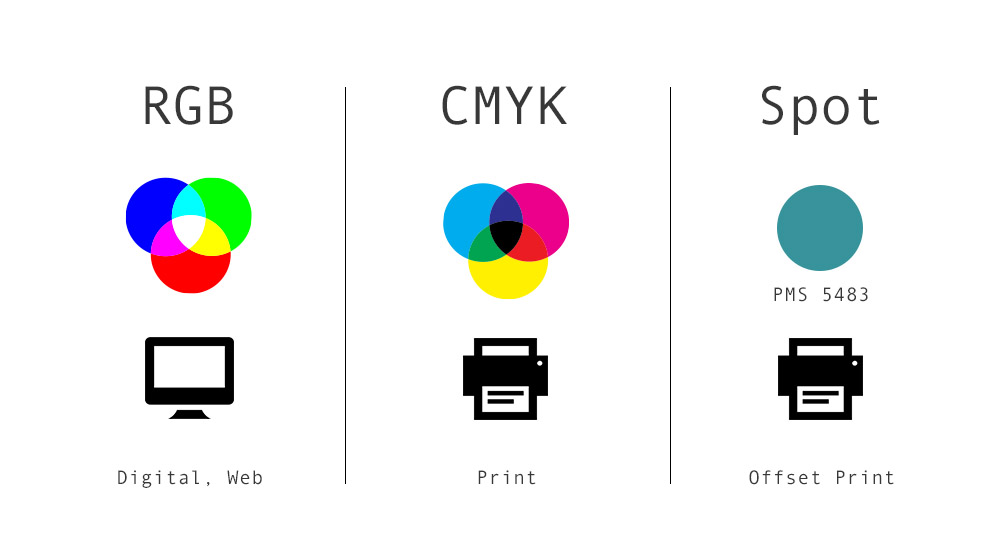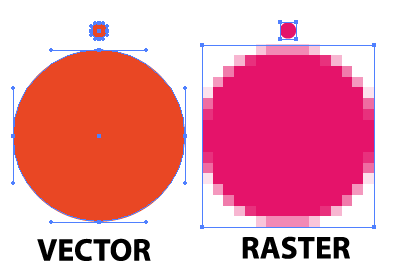Congrats! Print design is a really fun area of graphic design but it does require some specialty knowledge.
If you really love print design, you might look into becoming a Production Artists. Production Artists are a type of designer that specialize in the formatting, processing, and checking of print, packaging, and point-of-purchase graphics.
Quick Look
| Digital | ||
| Resolution | 72 dpi | 300 dpi (sometimes 150dpi is OK) |
| Color Profile | RGB | CMYK preferred |
| Type of Graphic | Raster and Vector | Vector |
| File Types | PDF, SVG, PNG, JPEG | PDF, EPS |
| Program to Use | anything | Illustrator or InDesign |
Color Settings: CMYK
Documents being sent to professional printers should always be designed in CMYK.
Cyan – Magenta – Yellow – Black
These are the 4 ink colors printers use to create color, detail, and contrast. CMYK is a subtractive color model. This means that all the colors combined will end up creating black, gradually subtracting lightness the more you mix ink (or paint). Sometimes CMYK looks more dull.
How to create a document in CMYK?
It’s recommended to start in CMYK from the get-go in your New Document settings here:

Though not ideal, it is possible to switch color profiles after starting by going to Edit > Edit Colors > Convert to CMYK in Illustrator (similar in all Adobe programs).

Sometimes it can be OK to design a print document in RGB for small home printers.
Red – Green – Blue
RGB is additive – you start with darkness and by adding luminosity or lightness it results in light. Digital screens use this model – if you look closely at some white screens, you can see tiny specks of red, green, and blue. Black is made by turning/dimming the pixels.

Vector vs. Raster

Raster graphics are composed of pixels. They are an array of colored pixels that form a rich, detailed images. Any mathematical curves and shapes are only pixel approximations. Most web graphics and all photographs are raster. a
– File types: PNG, JPG, GIF, TIFF, and PSD
– Main program: Photoshop
Vector graphics are composed of paths. Because vector paths are made of mathematical equations, they can be scaled up or down infinitely without losing quality. Crisp, simplistic, and geometric designs like logos and large-scale print graphics are vector.
– File types: EPS, SVG, AI
– Main program: Illustrator
DPI
DPI, or dots per inch, is a measure of resolution (sometimes PPI, pixels per inch). For print jobs, printers will typically request a high DPI: 300 at most, 150 lowest. 72dpi is standard for digital-only graphics.
300dpi means a printer will print 300 dots of color every square inch.

DPI is really tricky because a 72 dpi photo might look fine on your monitor but once printed be a pixelated mess. This is why it is crucial to choose large and high-DPI photos for large-scale print projects.
DPI can be changed in your new document settings just like CMYK.

Photo Choice
It is important to pick large, high-quality photos for print projects so they don’t print pixelated. See this pixel to inch conversion table below, but know these are rough estimates, there is no direct pixel-to-inch conversion because pixels and “dots” can be subjective unit of size.

Never size up raster photos for print.
IT’S NOT WORTH IT YOU WILL REGRET ! Put that transform tool down…..and Look for a better quality photo!!
If you have literally no choice, you can follow this tutorial but seriously don’t go nuts like doubling the image size or something.
Avoid grabbing low-quality photos from Google.
Check their sizing and resolution if you have to, or use high-quality photo sources like trusted stock photo sites.

